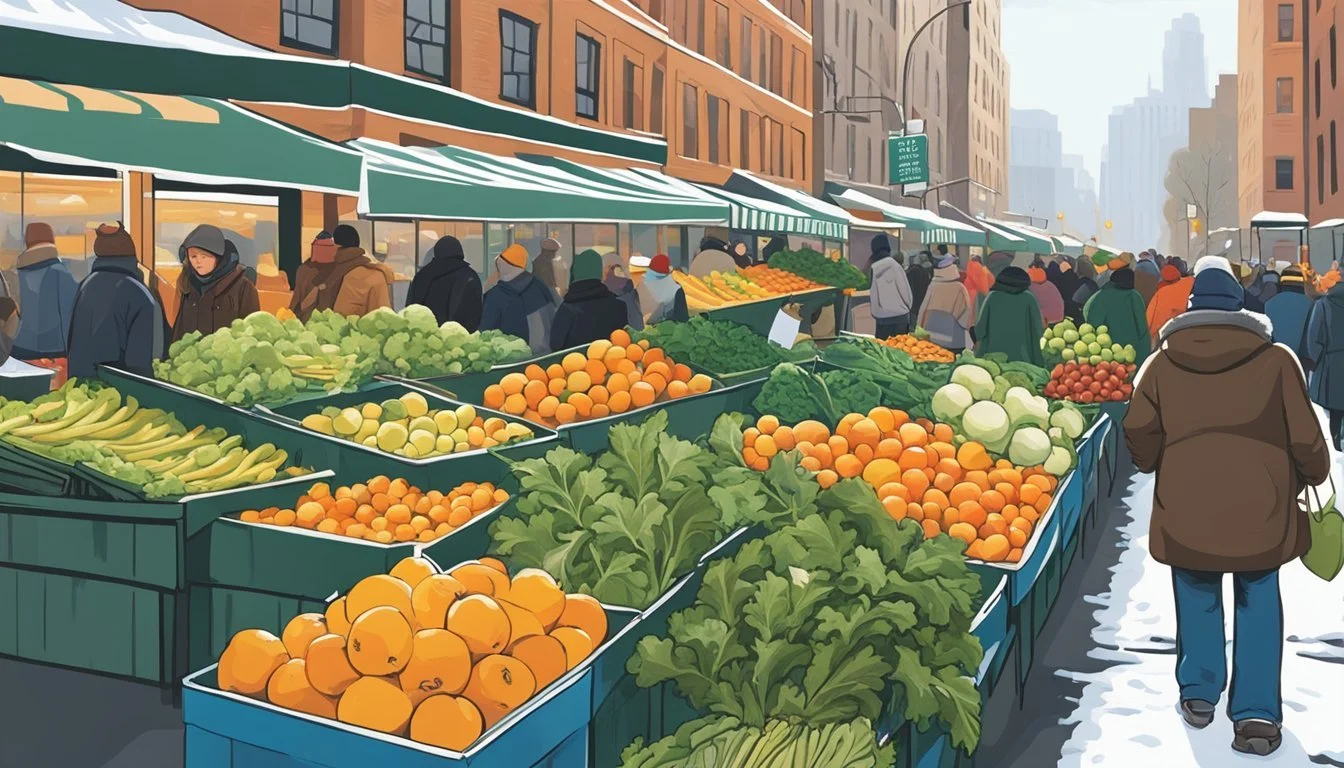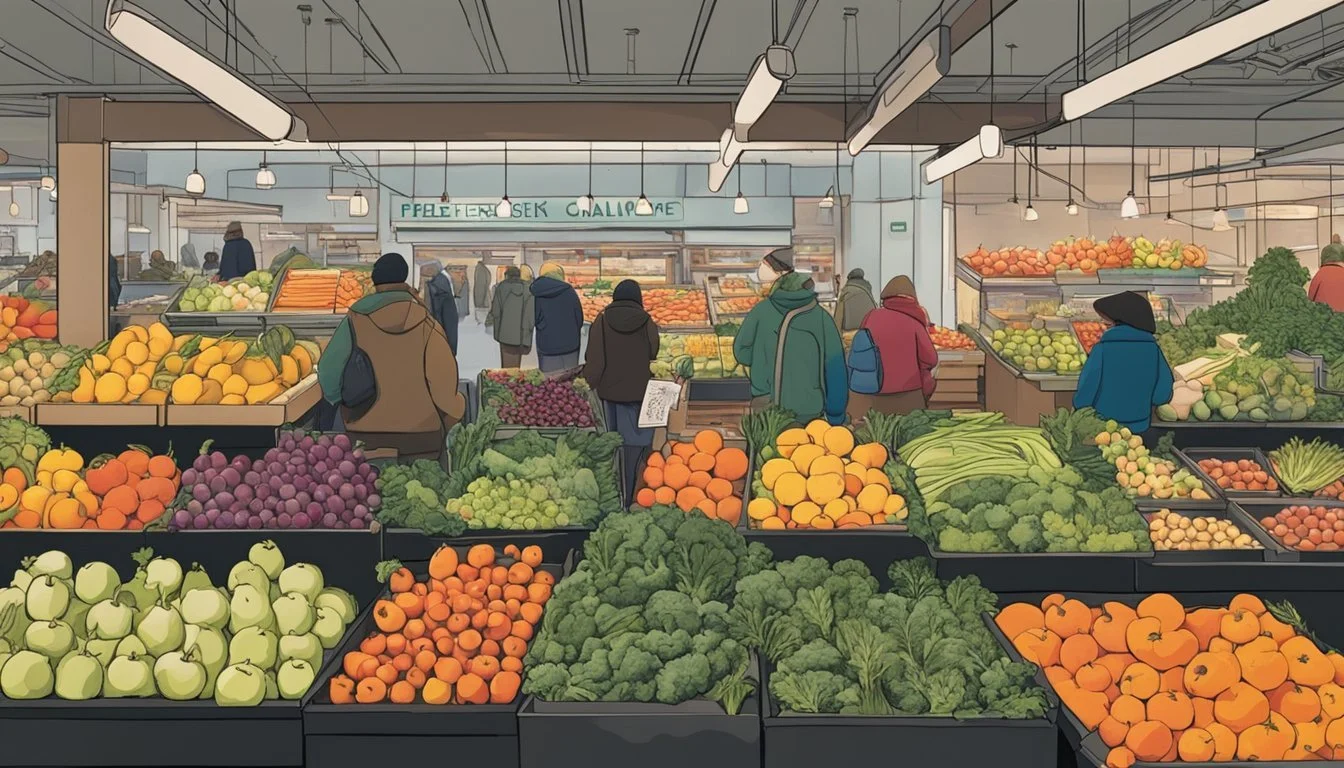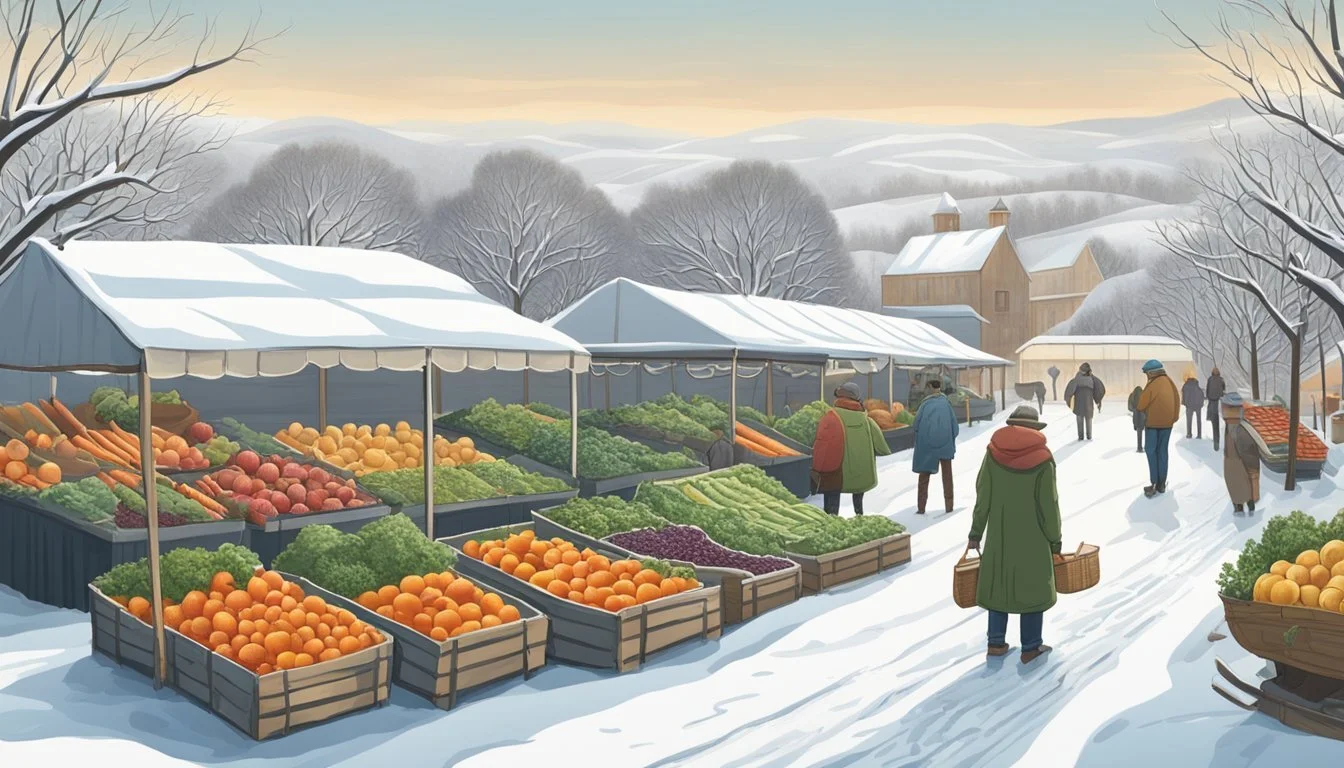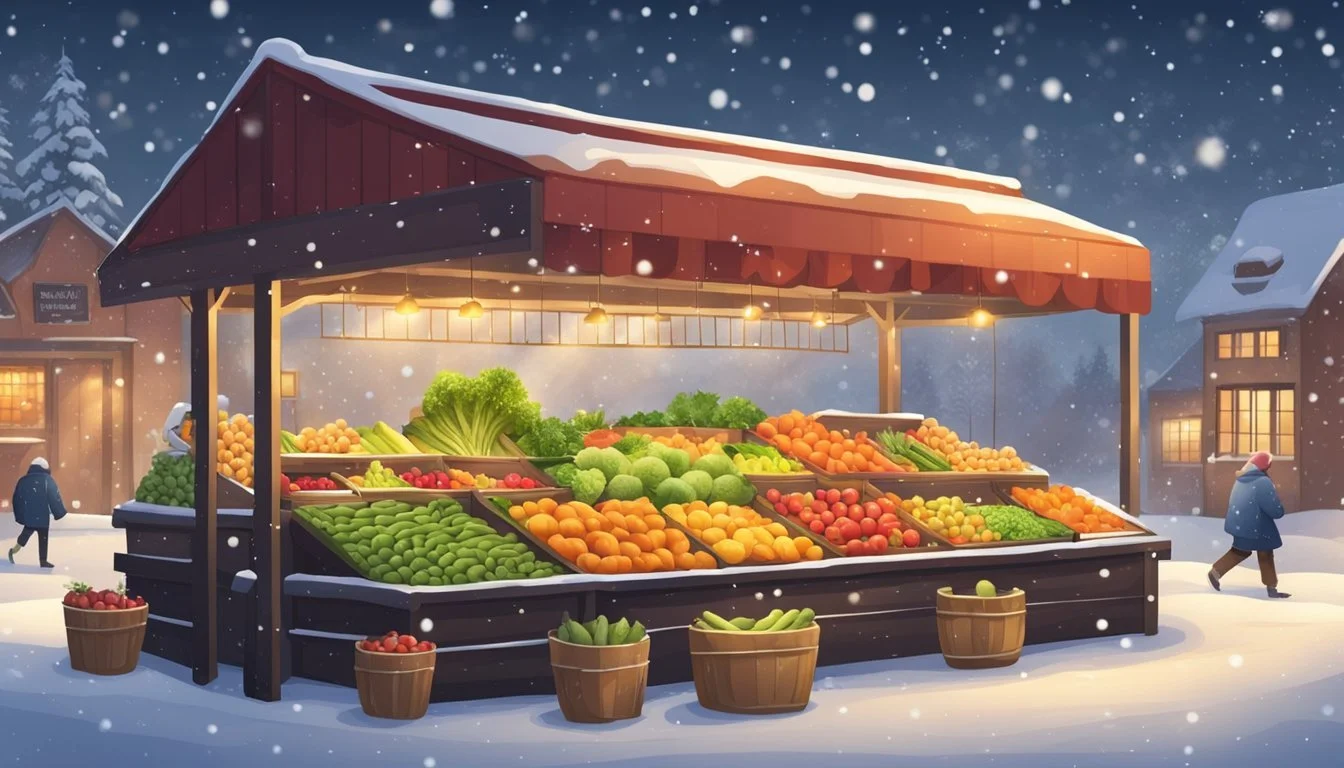New York Seasonal Fruit & Vegetables in January
Your Fresh Produce Guide
This Article is Part of our New York Seasonal Fruit & Veg Calendar
While January in New York may not evoke images of bountiful harvests, the state's farmers and markets continue to offer a variety of seasonal produce during the colder months. Root vegetables and hardy winter greens are the stalwarts of the season, providing depth and flavor to winter cooking. New York's climate, with its cold temperatures and frost, lends itself to the cultivation of produce that can withstand the less hospitable conditions, ensuring that local food systems remain active and that residents have access to fresh, locally-sourced fruits and vegetables.
Among the produce that thrives in January's chill are storage crops such as apples and pears, which are often harvested in the fall and available through cold storage techniques into the winter months. These fruits retain their freshness and flavor, making them a staple in the New York diet during winter. Indoor greenhouse operations and controlled environment agriculture also play a significant role, allowing for the supply of some fresh greens and herbs despite the snow and frost outside.
In addition to the fruit offerings, the vegetable selection includes hardy winter squashes, carrots (how long do carrots last?), potatoes, and onions. These vegetables are not only seasonally appropriate but also rich in nutrients, perfect for fortifying meals against the winter chill. Such seasonal availability underscores the resilience of New York's agricultural sector and the dedication of its farmers to provide sustainable, year-round produce to their communities.
Understanding Seasonality in New York
The agricultural landscape of New York is influenced heavily by the seasonality factor, with winter bringing a marked change in what produce is available. The growing season and weather patterns are fundamental determinants of crop availability.
Significance of Growing Season
The growing season in New York varies considerably across the state, largely due to its diverse climate. A shorter growing season upstate, compared to other regions, can limit the types of vegetables and fruits that can mature. Winter notably impacts the growing season, as many crops cannot survive the frost and cold temperatures, making certain produce less available during this time.
Weather Impact on Produce
Weather plays a pivotal role in determining the quality, quantity, and availability of produce. During winter, cold-hardy crops can withstand the freezing temperatures. However, severe winter weather conditions like heavy snowfall, ice storms, and extended freezing periods can delay planting times and affect harvests. Certain crops may become scarce in markets due to these weather interruptions.
Typical Winter Produce Weather Conditions Affecting Growth Root vegetables (e.g., turnips, beets) Resistant to cold, frost conditions Winter squash Harvested before heavy frosts Apples (late varieties) Some varieties store well into winter Hardy greens (e.g., kale) (What wine goes well with kale?) Can survive mild frosts, enriching their flavor
New York's produce selection in January often reflects the resilient nature of winter crops, while some stored produce from the previous growing season, like certain apple varieties, remains available.
Seasonal Fruits Available in January
January in New York brings a selection of fruits that can withstand the cold weather, offering rich flavors and nutritional benefits despite the chill. Here are some of the specific fruits one can enjoy during this month.
Citrus Fruits
In January, citrus fruits come into prominence in New York. They are celebrated for their vitamin C content and bright flavors. Typical varieties available include:
Oranges: A staple in the citrus category, providing a refreshing zest during winter months.
Grapefruits: Known for their slightly bitter taste and energizing qualities.
Winter Specialties
There are fruits that thrive in the cold and are harvested during or just before January, preserving their sweetness and texture:
Persimmons: They reach their peak sweetness in the winter and can be enjoyed fresh.
Pomegranates: With jewel-like seeds, these fruits add a burst of sweet and tart flavor to winter recipes.
Storage Apples and Pears
Apples and pears picked in the fall are kept in cold storage to extend their availability into the winter months:
Apples: A variety of apples such as Fuji, Gala, and Granny Smith remain crisp and flavorful from controlled storage.
Pears: Similar to apples, pears like Bartlett and Anjou are stored and retain their quality through January.
Seasonal Vegetables Available in January
January in New York brings a variety of vegetables that can withstand the chilly weather. Root vegetables and winter squashes are at their peak, offering robust flavors and hearty ingredients for winter dishes.
Root Vegetables
Root vegetables thrive in the cold, storing energy in their roots which makes them deliciously sweet and perfect for January harvests.
Beets: Earthy and rich, they can be roasted, boiled, or steamed.
Turnips: Offer a slightly peppery taste and can be mashed or roasted.
Celeriac: Known for its unique flavor, it can be used in soups or as a potato substitute.
Leeks: With a mild onion-like taste, they are ideal for adding depth to soups and casseroles.
Leeks and turnips are especially popular in New York during this time, known for their versatility and storage endurance.
Green Leafy Vegetables
Despite the cold, some green leafy vegetables manage to sustain through January, providing fresh nutrients and color to meals.
Kale: A nutritional powerhouse, it can be used in salads or sautéed as a side.
Spinach: Tender and quick to cook, perfect for salads, soups, or a sauté.
These leafy greens, particularly kale and spinach, are not only resilient in colder weather but also highly nutritious, making them popular choices for winter cuisine.
Winter Squashes
Winter squashes are a staple in January, as they store well and have a sweet, nutty flavor that intensifies over time.
Butternut squash: (how long does butternut squash last?) Its smooth, sweet flesh is ideal for soups and purées.
Acorn squash: Best roasted or stuffed, it provides a slightly sweet and earthy flavor.
These squashes can act as a main dish or a complementary side with their comforting and rich textures.
Preparation and Storage Tips
Proper storage can significantly extend the life and quality of produce, allowing one to enjoy New York's seasonal fruits and vegetables at their best. It is essential to understand that not all produce has the same storage requirements and handling ripe food items carefully ensures reduced waste and better flavor.
Vegetable Storage
Root Vegetables (such as beets): They should be stored in a cool, dark place, like a root cellar, to maintain their freshness. If a root cellar isn't available, they can be kept in the refrigerator.
Leafy Greens (like kale): These vegetables are best kept in the refrigerator's crisper drawer inside a loosely sealed plastic bag to retain moisture without accumulating excess water.
Cruciferous Vegetables (such as broccoli (how long does broccoli last?)and cauliflower(how long does cauliflower last?): Store them in a high-humidity crisper drawer, and keep them unwashed until use to prevent mildew.
Fruit Storage
Citrus Fruits: Citrus fruits like lemons and limes should be stored at room temperature if they will be used within a week, otherwise, refrigerate to extend freshness.
Apples: Store apples in a plastic bag in the crisper drawer of the refrigerator. They emit ethylene gas which can cause other produce to ripen prematurely, so they should be stored separately.
Note: Always handle food with clean hands and use clean tools to cut or prepare produce to reduce the chance of contamination.
Local Harvests and Farming Practices
January in New York sees local farms coping with cold weather while producing seasonal crops. Sustainable practices and the debate between organic and conventional methods are central to these operations.
Sustainable Farming
Farmers across New York State implement sustainable practices to maintain productivity during the short January days. These methods focus on soil conservation, water management, and energy efficiency. Sustainable techniques often include crop rotation, cover cropping, and controlled grazing. These efforts support the local ecosystem's health and ensure farms can continue to harvest crops like winter squash and root vegetables throughout the season.
Organic vs Conventional
The choice between organic and conventional farming influences New York's harvest in January. Organic farms avoid synthetic pesticides and fertilizers, relying on natural compost and biological pest control. This approach underscores a commitment to environmental health and the production of chemical-free produce. Conversely, conventional farms may use chemical aids to bolster the winter harvest. Both forms coexist, with consumers often prioritizing organic options for their perceived health benefits.
Health Benefits and Nutrition
In New York, consuming seasonal fruits and vegetables during January offers substantial health benefits and optimal nutrient content. These local produce selections are not only fresher but tend to be more flavorful and nutrient-dense.
Health Advantages of Seasonal Eating
Seasonal eating in January can bolster one's health through an increased intake of vitamins and minerals which are preserved at their peak. For example, eating pumpkin, prevalent in the winter months, supports the immune system due to its high vitamin A content. Vegetables like kale and collards are also abundant and can improve one's diet with their rich nutrient profiles, including antioxidants that reduce inflammation.
Pumpkin:
Boosts immunity
Promotes healthy skin and eyesight
Kale and Collards:
Provide antioxidants
Support cardiovascular health
Nutrient Content in Fruits and Vegetables
The nutrient content in January's fruits and vegetables reflects their freshly-harvested state. Locally sourced produce like apples, still available in New York during winter, are high in dietary fiber and vitamin C, which contributes to digestive health and immune defense.
Apples:
Dietary Fiber: Essential for good digestive health
Vitamin C: Strengthens the immune system
Root vegetables such as sweet potatoes and carrots, which store well through the cold months, deliver essential vitamins and beta-carotene, recognized for its role in maintaining good vision and healthy skin.
Sweet Potatoes:
Vitamin A: Vital for vision and immune function
Vitamin C: Necessary for collagen production and repair
Carrots:
Beta-Carotene: Converts to vitamin A in the body
Vitamins K and B6: Important for bone health and energy metabolism
These examples illustrate the vast nutritional benefits tied to eating seasonal produce in New York during January.
Seasonal Recipes and Cooking Ideas
As the frosty weather of January grips New York, residents can embrace the cold with a range of heartwarming dishes. Below are ideas for incorporating January's fresh produce into comforting meals.
Winter Stews and Soups
Stews and soups are quintessential for January's colder days. They offer a method to combine various seasonal vegetables such as kale, leeks, and cauliflower into nourishing meals.
Kale and White Bean Stew: A warm, rich stew that blends the earthiness of kale with creamy white beans.
Cauliflower Soup: A smooth, creamy soup that highlights cauliflower's subtle flavors, often garnished with a sprinkle of sharp cheddar.
Seasonal Salads
Salads might seem counterintuitive in winter, but with the right ingredients, they can be both refreshing and fitting for the season.
Citrus and Kale Salad: Bitter kale paired with sweet, juicy segments of orange for a vibrant, nutrient-dense dish.
Broccoli and Quinoa Salad: A hearty salad combining steamed broccoli with protein-rich quinoa (how long does quinoa last?), tossed in a light lemon vinaigrette.
Preserving Techniques
Preserving allows chefs and home cooks to extend the life of seasonal produce well into the year.
Pickling: Vegetables like cauliflower and broccoli can be pickled with a simple brine, adding a tangy twist to dishes.
Canning: Fruit preserves, such as citrus marmalade, capture the essence of January's citrus harvest for enjoyment year-round.
Impact on Local Economy
The economic vitality of New York state, particularly in January, is closely interlinked with the activities of local farmers and seasonal markets. These entities play a crucial role in sustaining the state's economy through this lean month.
Supporting Local Farmers
Local farmers are fundamental to New York's economy. By producing seasonal produce even in January, they help maintain a viable economic structure within the state. A portion of New York's revenue is attributable to the agriculture sector, with local farms contributing to the food supply chains that have been developed over decades. These farms, albeit limited by the cold January weather, still manage to supply markets with cold storage crops from the previous seasons, such as apples.
Seasonal Markets
Seasonal markets adapt to the colder month by offering goods that are available during January. They become focal points for community engagement and economic activity. The markets not only provide a platform for farmers to sell their produce directly to the consumers but also stimulate local economy by keeping the revenue within the state and local communities. Consumers frequenting these markets appreciate the access to fresh, locally-sourced produce, which, despite the limited variety in January, supports the economic cycle.
Monthly Guides and Resources
For individuals seeking information on seasonal fruits and vegetables in New York during January, various guides and resources are available. These compilations provide valuable insights into what produce to expect in local markets, corresponding to the season's availability.
Consumer Guides
Consumers can access a variety of guides that detail the seasonal availability of produce. These guides typically offer month-by-month breakdowns of fruits and vegetables, enabling consumers to make informed purchasing decisions. For example, resources such as the "FoodPrint Seasonal Food Guide" app allow users to select January and view which items are currently in season in New York.
Fruits in Season:
Apples (from cold storage)
Pears (from cold storage)
Vegetables in Season:
Carrots
Potatoes
Winter Squash
Onions
Agricultural Calendars
Agricultural calendars serve as an essential tool for both farmers and consumers, outlining the harvest and market availability of various crops. These calendars usually account for factors such as geographical location within the state and typical weather conditions, which influence the growth cycles of produce.
January Availability in New York:
Harvesting may include:
Root vegetables such as carrots and beets from storage
Hardy greens such as kale, under protection
Planting/Growing is generally focused on indoor or protected cultivation due to the cold winter temperatures.
Conclusion
In New York, January's frigid conditions influence the availability of fresh produce. However, consumers still enjoy a selection of fruits and vegetables that are peak seasonal offerings. The local harvest yields root vegetables and sturdy greens, which can withstand the cold climate.
Key produce includes:
Apples: Stored from fall harvest, still crisp and sweet.
Pears: Similarly kept in cool storage, offering a juicy option.
Potatoes: A hearty staple, versatile for many dishes.
Carrots: Offering a fresh crunch, they are perfect for winter soups and stews.
Cabbages: They thrive in colder weather, adding nutrition and flavor to meals.
Onions and garlic: Essential for cooking, readily available.
These items reflect the regional capacity to provide nutritious and flavorful ingredients despite the season's limitations. It ensures that residents and chefs can rely on certain local produce even in the depths of winter. Purchasing these seasonal items supports local farmers and reduces the carbon footprint associated with long-distance food transport.
It is essential for consumers to understand that weather conditions and farm locations may shift availability slightly. Responsibly sourced and seasonally available products may vary but generally align with these trends in New York's January offerings.











